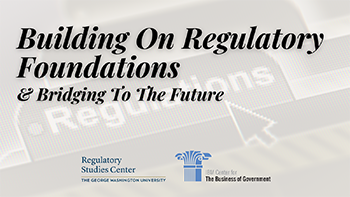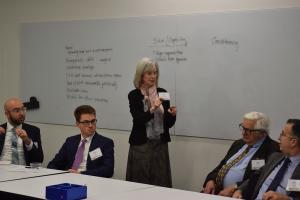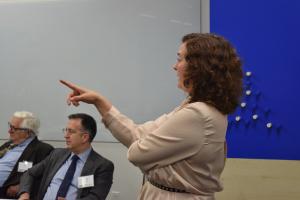
Summary: Is OIRA Still Fit for Purpose?

On November 16, 2023, the George Washington University Regulatory Studies Center and the IBM Center for the Business of Government co-hosted an event, Building on Regulatory Foundations and Bridging to the Future, commemorating the 30th anniversary of Executive Order 12866 and 20th anniversary of Circular A-4. Taking place a couple weeks before ChatGPT’s first birthday, the event featured several breakout sessions, including one focused on whether the Office of Information and Regulatory Affairs (OIRA), created in 1981, is still fit for purpose. Bridget Dooling, currently an assistant professor of law at the Ohio State University and previously a research professor with the George Washington University Regulatory Studies Center and deputy OIRA branch chief, led the discussion.
Attendees of this breakout session debated a series of interrelated questions: What is OIRA’s purpose? Has its purpose changed over time? And is OIRA currently capable of fulfilling its purpose?

There was general consensus regarding OIRA’s original purpose: Its primary function was to serve as a rational bureaucracy, staffed by apolitical generalists capable of mediating between competing interest groups within the government in order to produce regulations that yield the greatest net social benefit. OIRA desk officers must evaluate the analyses underlying agencies’ regulatory proposals against fundamental economic and statistical principles. OIRA’s secondary function was to facilitate coordination and oversight in the regulatory process, so as to provide greater transparency and accountability to the elected president.
The breakout session attendees also agreed that OIRA’s purpose has changed over time in two major ways. The first significant development is a consequence of the increasingly technical content of the proposed rules OIRA is tasked with reviewing. In response to this complexity, OIRA has been forced to adopt a more specialized function than it was originally intended to fulfill. The office can no longer assess proposed regulations by relying solely on economic and statistical analyses. Rather, it must now supplement those core competencies with deep analyses of scientific and technological subjects.
The second change involves the politicization of the office. While OIRA–created by President Reagan–was initially perceived as having a deregulatory agenda, the perpetuation of the office in the Clinton administration gave it a nonpartisan reputation. The apolitical nature of the OIRA staff enabled them to provide regulatory continuity over the years, despite the turnover of administrations. Breakout attendees worried that OIRA has become more politicized in recent years, harming its image and detracting from its primary analytic function. While there will always be a tension between OIRA’s role as an analytical reviewer and its role as a representative of the elected president, participants thought it could more effectively fulfill its purpose if it were perceived as less political.
Breakout participants were split evenly on the question of whether OIRA currently has the capacity to fulfill its purpose. Those who believed that OIRA is still fit for purpose highlighted its stellar analytic capabilities, its wealth of institutional knowledge, the time-tested role that it performs within the executive branch, the esteem in which the president holds the office, and its archetypal position within the international regulatory community.
Other attendees believed that OIRA could improve in various ways. Some thought that in comparison to the regulatory agencies of some other countries, OIRA’s approach to regulation insufficiently fosters technological progress. More specifically, they highlighted the pro-innovation regulatory approach used in South Korea which involves innovation reviews of entire fields, such as autonomous vehicles. Participants noted that OIRA would require additional staff to develop similar capabilities. A related but distinct critique of OIRA was a perceived lack of an aspirational global regulatory vision on topics of universal importance (e.g. climate change) and its corresponding failure to network adequately with the regulatory agencies of other countries.

While attendees lauded the capabilities of the current OIRA staff, others worried that the office is still too small to handle the deluge of draft rules sent to it for review. As of November 2023, OIRA has approximately 67 full-time employees, a number which has remained largely unchanged over the years as the demands placed upon the office have dramatically increased. Concerned attendees proposed that OIRA would benefit from the addition of more subject matter specialists, particularly in burgeoning fields such as artificial intelligence. Others voiced their concern that increasing OIRA’s staff too much could diminish its nimbleness and responsiveness.
Some argued that OIRA does not proactively communicate with other federal agencies and academic institutions. OIRA is viewed by many as an inscrutable black box, and consequently as an impediment to effective regulation. For this reason, several attendees recommended proactively teaching agencies and universities how OIRA functions and how they can constructively interact with it. This might entail training programs for members of other agencies and educational initiatives in both law and public affairs schools. Participants agreed that OIRA currently lacks an external constituency supporting its mission, and thought greater outreach could address that issue.
By the end of the breakout session, the attendees generally agreed with the following characterization of OIRA’s trajectory:
The demands placed upon OIRA have changed throughout its lifetime. Nevertheless, the office has always managed to achieve its core analytic purpose, frequently adapting its approach in response to novel technical and political challenges. Whether OIRA can continue to fulfill its purpose in the contemporary regulatory landscape without increasing its staff and expanding the scope of its activity remains to be seen.



